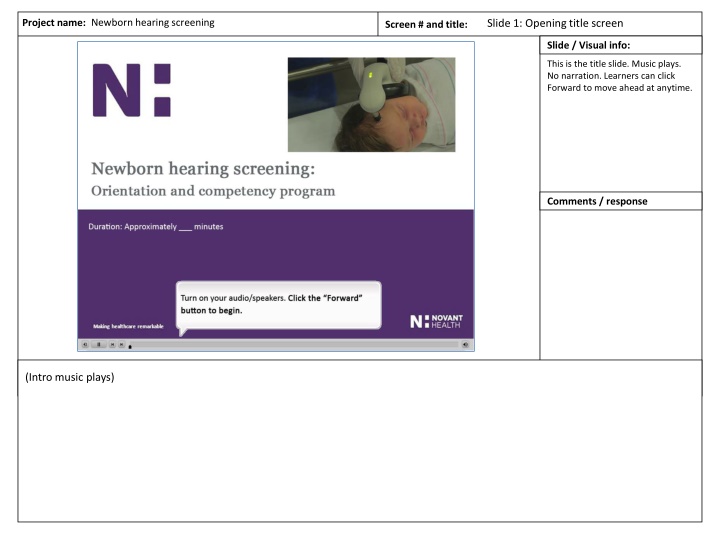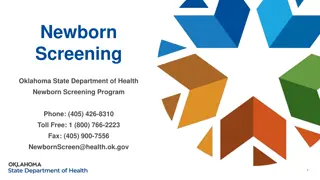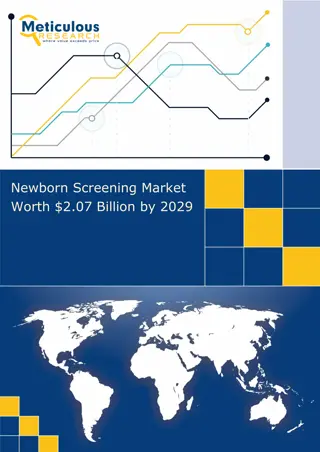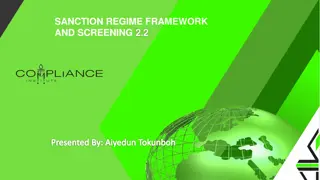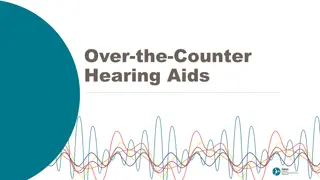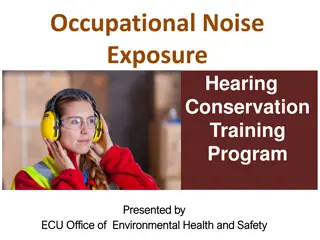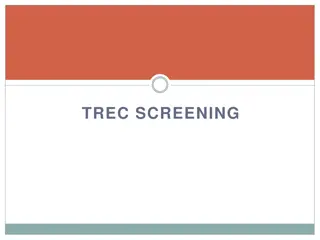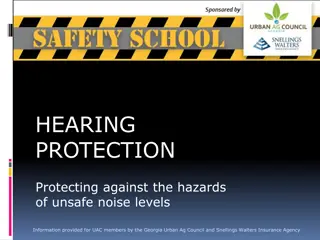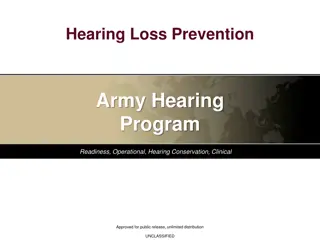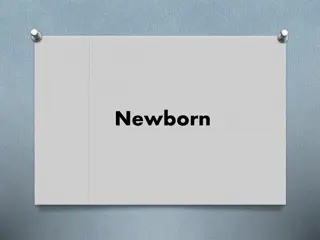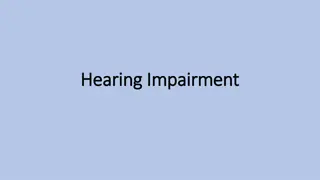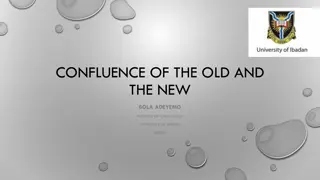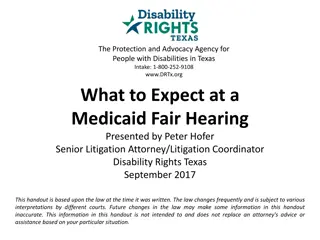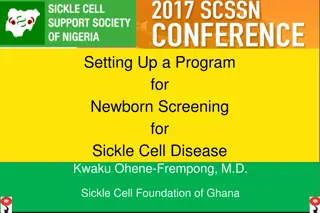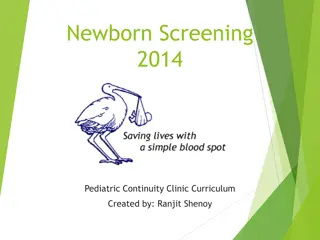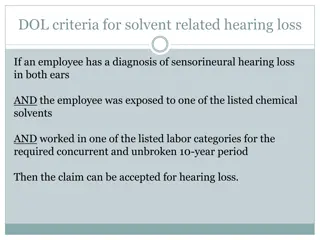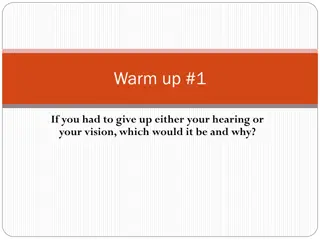Newborn Hearing Screening Program Overview
The Newborn Hearing Screening Project aims to educate healthcare professionals on the importance of early identification of hearing loss in infants. The program discusses the significance of timely intervention, the impact of undetected hearing loss on child development, and provides guidelines for conducting hearing screenings effectively. Through a series of slides and audio-based content, learners are guided on the essential aspects of newborn hearing screening, including objectives, basics of how the ear works, screening procedures, and best practices. The comprehensive course equips participants with the knowledge and skills to perform screenings confidently and educate families on the results and implications of hearing loss in newborns.
Download Presentation

Please find below an Image/Link to download the presentation.
The content on the website is provided AS IS for your information and personal use only. It may not be sold, licensed, or shared on other websites without obtaining consent from the author.If you encounter any issues during the download, it is possible that the publisher has removed the file from their server.
You are allowed to download the files provided on this website for personal or commercial use, subject to the condition that they are used lawfully. All files are the property of their respective owners.
The content on the website is provided AS IS for your information and personal use only. It may not be sold, licensed, or shared on other websites without obtaining consent from the author.
E N D
Presentation Transcript
Newborn hearing screening Project name: Slide 1: Opening title screen Screen # and title: Slide / Visual info: This is the title slide. Music plays. No narration. Learners can click Forward to move ahead at anytime. Comments / response (Intro music plays)
Newborn hearing screening Project name: Slide 2: Video intro - Michelle Screen # and title: Slide / Visual info: This slide contains animation. Comments / response Hi Michelle, and I m a pediatric audiologist. Today, we are going to talk about the Newborn Hearing Screening program at Novant Health. Early identification of hearing loss in children was becoming standard of care for NICUs and Newborn nurseries long before it became federal law in 2000. We know that the earlier a baby is identified as having hearing loss, the earlier we can intervene with amplification and education so that these children develop along side their normally hearing peers. Unidentified hearing loss in children leads to developmental delays in speech, social skills and reading ability. For example, if a hearing loss is not identified until the child is 3 years old - the typical time for building blocks of communication and social interaction has been lost. They are often frustrated not able to communicate their needs to parents or others. They may exhibit what is perceived as behavioral problems. Think about it; they are not able to learn to read easily because they cannot sound out the words. All babies receive a hearing screening prior to discharge at all Novant Health facilities and when you begin providing screenings for these families, you will be the first touch point in their journey. This CBL was created to make sure you feel comfortable and confident performing hearing screenings and educating families regarding results and our program. Click the forward button to continue the course.
Newborn hearing screening Project name: Slide 3: Objectives Screen # and title: Slide / Visual info: Only audio. Comments / response Here are our learning objectives for this program. These links do not go anywhere. Please wait for the video to begin.
Newborn hearing screening Project name: Slide 4: Basics of how the ear works Screen # and title: Slide / Visual info: Audio only Comments / response Take a few minutes to revisit how the ear works.
Newborn hearing screening Project name: Slide 5: Quiz question Screen # and title: Slide / Visual info: Comments / response
Newborn hearing screening Project name: Slide 6: Screening tips Screen # and title: Slide / Visual info: Comments / response Before we get started with the screening process, lets go over some best practice screening tips. Hearing screen should be done in the parents room. This supports our Baby Friendly Hospital Initiative and also involves parents in a positive way in the care of their infant. Ideally, hearing screens should be performed as close to discharge as possible. However, in all cases, hearing screens should not be attempted before 8 hours of age, to allow the infant time to stabilize after delivery. It is easiest to obtain an accurate hearing screening with the baby in a calm, sleepy state. Do not try to screen a baby that is crying and about to eat. After prepping the baby, and giving time for the baby to calm, begin the screening. The baby can be in the bassinette or held by a parent. Sometimes, babies will be most calm for testing if completed while nursing.
Newborn hearing screening Project name: Slide 7: Understanding your equipment Screen # and title: Slide / Visual info: The links and instruction to click here will not be visible or active until after Michelle finishes her narration for this slide. Comments / response All infants are screened using AABR technology which measures the response of the brainstem through the auditory nerve. You may have heard of OAE technology being used for hearing screening. This method measures a response specific only to the cochlea. At Novant Health, there are two different instruments being used, the Algo and the Beraphone. Impedance is the quality of the connection between the equipment and the baby. On the Algo, impedance is measured by the sticker electrodes. On the Beraphone, it is measured by the electrodes connected to the phone itself. We ve already talked about the importance of a quiet and calm baby. A quiet environment is equally important. High levels of ambient noise will prolong a screening. High levels of biological noise (sucking, wiggling) will interfere with data collection during the test. The baby must be VERY still. Swaddling or having someone hold the baby closely may increase success here! Please click the link for the equipment used at your facility. A video will display in another window. After the video has completed, please return to this window and continue the CBL.
Newborn hearing screening Project name: Slide 8: Hearing screening terms Screen # and title: Slide / Visual info: Comments / response Let s talk vocabulary: You are performing a hearing screening test. This test is comprised of up to two trials. Per Novant Health policy, which can be accessed through the link on this slide, if an infant refers on one or both ears on the first trial, they should receive a second trial as close to discharge as possible to complete the screening test. It is important that you understand and speak about hearing screening in this way so that we are compliant with state regulations about hearing screening. We use the word pass, generated by the equipment to identify infant who demonstrate brainstem response during testing. We use the word refer, again, generated by the equipment, to identify infants who need further investigation of their hearing ability. Do not use the word fail for infants who refer. With this level of testing, we cannot assume hearing loss. But, we also need to trust the equipment since it raises more questions. Infants that refer with the second trial, should be referred to the provider for referral to an appropriate resource for further testing. Impedance is the quality of the connection between the equipment and the baby.
Newborn hearing screening Project name: Slide 9: Talking to parents Screen # and title: Slide / Visual info: Comments / response When you are performing the test in the parents room, parents may have a lot of questions. It is important to explain to parents about the procedure before you begin. You could say something like this: A hearing test is a procedure we do on all infants. I am going to do a hearing test on your baby right now. First, I am going clean the skin and then place this equipment next to your baby s ear. It will make soft ticking sounds that your baby s brain will register and give feedback back to the equipment that will record your baby s brain response. Remember to use the words your baby s brain rather than your baby. Parents may look for a physical response from their baby if you do not clarify. Some parents will ask about the scrubbing. Try to remember to call it a cleaning. Do not say We are doing this test to see if your baby can hear. If parents ask, tell them that hearing screening is a way to identify babies that need further testing for hearing. Rollover the link on this slide to hear a typical conversation with the parent about the test.
Newborn hearing screening Slide 10: Talking to parents: Discussion of results Project name: Screen # and title: Slide / Visual info: Comments / response So, now you have completed the testing. If the baby passes, it is still important that you provide education to the family. Each family receives a handout (attach) that states the screening result and provides information on developmental milestones that are associated with hearing. Please point out this helpful information to the family and let them know that if they ever have concerns regarding their child s hearing or speech they can contact their pediatrician for a recheck with Audiology. If the baby refers, this means that further investigation is needed to determine the baby s hearing status. There is a fine line between comforting the family after refer results and planting the seed for them that there is no possibility that the baby has hearing loss. Resist the urge to rescue! These infants will be scheduled for follow up with audiology. But, if parents need to talk to someone today, give them the phone number and allow parents with questions to call from the bedside. It is natural that parents might be worried about receiving news that their baby referred on the hearing screening test. While it is true that follow up testing may confirm normal hearing, we cannot make that assumption. Do not tell parents that it is probably nothing that it is probably fluid in the ears or that you will re-do the test. Tell parents that their baby needs further investigation. Connect them with audiology. Rollover the links to hear talking points. There are also links to parent education and further tips on speaking with parents. When providing results keep it simple. Remember, you can call audiology from the bedside for further support.
Newborn hearing screening Slide 11: After completing the testing Project name: Screen # and title: Slide / Visual info: Comments / response After completing the testing, ALL babies should have results entered in Dimensions and Hearing Link (NC only). Ideally both results are entered by the person who completes the screening. If an infant has been referred, make a follow-up appointment with a certified audiologist before the infant is discharged. Most infants will be referred to the local NH audiology department. Contact information is on your unit. Calls during office hours, should be received by a person. Calls after hours leave a message and follow up with a Dimensions in-basket message with the baby s chart attached. Not sure how to do that?
Newborn hearing screening Project name: Slide : Quiz question Screen # and title: Slide / Visual info: Maybe more quiz questions here that cover the objectives. Comments / response
Newborn hearing screening Slide 12: Remember Project name: Screen # and title: Slide / Visual info: Comments / response You are the first point of contact for each family s potential journey through hearing loss. Our hospitals will identify 3 in 1,000 well babies (with a higher incidence in the NICU population). Our goal is to identify potential hearing loss and provide early intervention for best outcomes. Always consider that each baby you screen could have hearing loss. Refers are not common (typically less than 4% refer) and should not be considered insignificant.
Newborn hearing screening Slide 13: Next steps Project name: Screen # and title: Slide / Visual info: Comments / response You re almost finished. After completing the course credit question on the next slide, you will be ready to be validated on the unit for newborn hearing screening. Your preceptor will assist you to practice performing hearing screens on your unit and validate your competence in performing hearing screens and educating families. Be sure to look at the resource links on this page; especially the hearing screening competency checklist.
Newborn hearing screening Slide 14: Compliance question Project name: Screen # and title: Slide / Visual info: Comments / response
